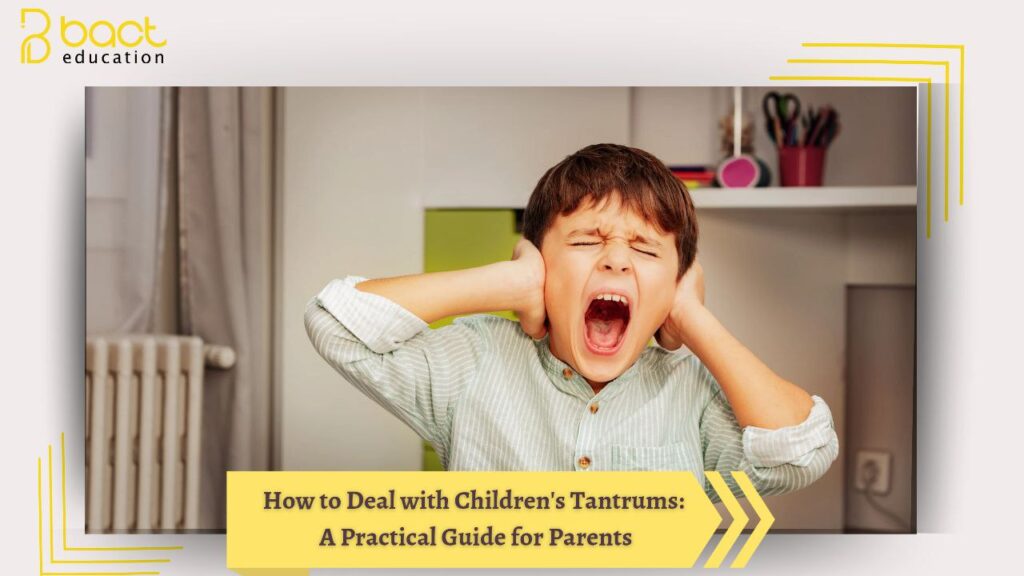* A Practical Guide for Parents**
Tantrums are a normal part of
childhood, reflecting a child’s
internal struggle between their desire for independence and their inability to fully express or control their emotions. These episodes can manifest as screaming, crying, kicking, or even throwing themselves on the floor. While these situations can be frustrating and confusing for parents, handling them with understanding and wisdom is the key to calming the child and teaching them emotional regulation skills.
**Causes of Tantrums:**
* **Inability to Communicate:** The child wants something (food, a toy, attention) but doesn’t have the vocabulary to explain what they want.
* **Hunger or Tiredness:** Basic physical needs like hunger, thirst, or fatigue are common triggers.
* **Need for Control:** As a child’s sense of self develops, they want to feel they have a say and control over their environment.
* **Frustration:** When they fail to complete a task (like building a block tower).
* **Seeking Attention:** Sometimes, tantrums are a way to attract attention, especially if the child notices that this behavior successfully achieves their goal.
**Practical Strategies for Dealing with Tantrums:**
1. **Stay Calm:** This is the most crucial rule. If you lose your temper, you will only make the situation worse. Take a deep breath and remember that this is normal behavior and not a personal attack on you.
2. **Ensure Physical Safety:** If the child is endangering themselves or others, move them calmly to a safe place. Hold them gently if it helps them calm down, or stay nearby to ensure they don’t hurt themselves.
3. **Don’t Give In to Their Demands:** Giving in to a child during a tantrum teaches them that screaming is a successful way to get what they want, reinforcing this negative behavior.
4. **Use Simple and Empathetic Language:** Instead of yelling, use short phrases that acknowledge their feelings: “I see you’re angry because we have to leave the playground” or “I know you’re sad because you want the candy.” This helps them feel understood and begins to connect their feelings with words.
5. **Offer Limited Choices:** Instead of giving direct orders, offer choices that give them a sense of control. “Do you want to wear the red shoes or the blue shoes?” instead of “Put your shoes on now.”
6. **Try to Distract Them:** Especially with younger children, distraction can be a magical tool. Point out something interesting outside, or start singing their favorite song.
7. **Give Them Space (For Older Children):** If the child is not in danger, you can stay nearby without interacting. Tell them, “I’m here for you when you calm down.” This teaches them that you are supportive but will not engage in their tantrum.
8. **Set Consistent and Clear Boundaries:** Children need to know the expectations. Be consistent with your rules. If the behavior is unacceptable (like hitting), explain it in a firm and simple way: “Hitting hurts. We do not hit.”
**After They Calm Down:**
* **Hug and Reassure Them:** Tell them you love them. This reinforces that their feelings are acceptable, even if their behavior is not.
* **Help Them Label Their Feelings:** “That was a big anger, wasn’t it?”
* **Teach Alternatives:** Teach them better ways to express anger, such as saying “I’m angry!”, punching a pillow, or drawing their feeling.
**When to Seek Professional Help?**
Consult your pediatrician if the tantrums:
* Are severely violent or last for long periods.
* Occur more than 5 to 10 times a day.
* Continue after the age of 4 or 5.
* Are accompanied by self-loathing or self-harm.
**Conclusion:**
Tantrums are an opportunity for learning, not a disaster. With your understanding, calmness, and consistent boundaries, you can help your child navigate this emotional storm and grow into an individual capable of understanding and managing their feelings in a healthy way.

